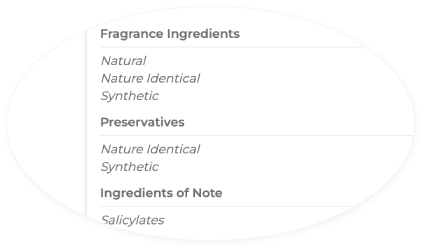A Close Look at Fragrances
Did you know the fragrance industry is largely self-regulated? There are 3,000+ fragrance ingredients in existence, many of which are concerning. Manufacturers aren’t required to disclose every single component they include in their products. They can simply use the word “fragrance.” We choose to dig deeper.
From the beginning, we set extremely high standards. We know not all ingredients are created equal. And we know everyone has their own criteria for what they are looking for in a product. That’s why we consult with 12+ sources, including government regulatory groups (like the EPA and the ECHA), chemistry databases (such as PubChem and PubMed) and advocacy groups (including EWG and Women’s Voices), to learn everything we can when researching every ingredient.
We pay particular attention to all fragrances and will not sell products that simply list “fragrance” as an ingredient without confirming that all ingredients or proprietary blends, meet our rigorous standards.
To even be considered, a fragrance must clear the following criteria:
- Is not a known endocrine disruptor.
- Is not a known carcinogen.
- Is not a known reproductive toxicant.
To date, fewer than 350 of the 3,000+ available fragrance ingredients have made it through our rigorous product selection process.
Click here to see our Ingredient Yes/No List.

Diving Deeper
Since the beginning of MightyNest, our focus has been solely on Natural Fragrances, such as essential oils. Guided by requests from our customers to broaden our line of products, we realized we needed to expand our research and knowledge when it comes to fragrances. So, we began digging deeper into ingredients. We began researching and evaluating Nature Identical and Synthetic Fragrance ingredients, and what we have learned is that the world of ingredients is complex.
There are benefits and drawbacks to both natural and synthetic fragrances, and each and every ingredient needs to be considered on a case-by-case basis.
Natural Fragrances
Natural Fragrances are derived directly from natural botanicals (plants, trees, fruits, etc). They include essential oils, oleoresins, distillates, fractions and isolates. For those who prefer all natural ingredients, natural fragrances provide a pleasant yet subtle scent.
Some downsides of natural fragrances are that they are among some of the most allergenic ingredients. There are also sustainability challenges with slow regrowth coupled with harvesting that sometimes kills the plant. And, sometimes, massive amounts of plant material are required for essential oil extraction. For example: It takes more than 220 pounds of rose petals to produce only 4 to 5 teaspoons of rose essential oil—which is why rose essential oil can cost between $300 to $800 per ounce.
Synthetic Fragrances
Nature Identical fragrances are created in a lab, but are chemically identical to an essential-oil counterpart existing in nature. They allow companies to harness the best of nature without relying on the availability or quality of materials that exist in nature; can be reliably replicated from year to year and batch to batch; and can be created without allergy concerns.
Synthetic Fragrances are created in a laboratory and can be made from both natural materials and petroleum by-products. Cost efficiency, scalability and sometimes even environmental friendliness can give synthetic ingredients an edge. These fragrances give companies the ability to create fragrances that mimic more obscure fragrance concepts like “ocean breeze”.
The downside of synthetic fragrances is that it is difficult to understand the potential risks that some of these fragrances contain. Also, many synthetic fragrances are proprietary blends considered to be trade secrets and require more intensive steps in order to confirm the formula meets our standards.
Through our rigorous product selection, we have identified many Nature Identical and Synthetic Fragrance ingredients that pass our review process. At the same time, we have identified many more that do not. Until we can gather enough information to ensure a fragrance meets our criteria for safety, we will not carry any product that contains it.
We also know everyone has their own set of criteria about what they are looking for in a product, and we are committed to being transparent so you can choose the best products for you and your family. This is why on the ingredient detail section of each product page we identify which fragrance type is in the product — Natural, Nature Identical or Synthetic as shown below.

We will continue to update our Ingredient Yes/No List as we encounter more fragrances that meet — or don’t meet — our criteria.
If you have a question that we haven’t answered or want further clarity on how we choose our products, please don’t hesitate to let us know.
